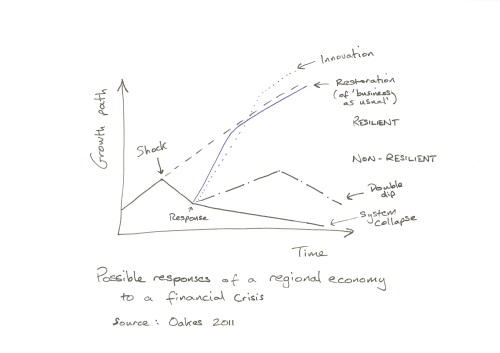Hats off to Geography Review.As a Geography teacher and afficionado, I do occasionally take a peek at the A Level quarterly publication. Often filled with fascinating articles on coastal erosion and glaciation, it is always in tune with some big issues. My interest was exacerbated recently when I noticed that the November 2011 issue contained some brilliant sections on peak oil, the impacts of climate change, and an article entitled ‘Eat Local?’ What really caught my eye was a double page spread on the meaning of resilience.
To me, resilience is a great word. Just saying it feels uplifting, especially when you reach (and stress) the second syllable. It always feels full of untapped possibilities and optimism. It is a word that wants to hang on in there and not let go.
Students seem to get it, by and large, provided it is discussed in the context of a real thing rather than just a concept. So, it can often crop up when looking at the ability of an area of countryside to cope with large numbers of tourists trampling over it, or a rural community dealing with the reality of drought and coming up with responses to get through it.
Anything that raises the profile of resilience has to be a good thing, so the fact that it was featured in the prestigious A level publication was very welcome. The article is called ‘Everybody’s talking about . . . Resilience’. Resilience is defined as ‘an ability to leap back or rebound following a disruption or a disaster’. So far, so good. It then adds how ‘academics, business leaders and politicians now embrace the word as a catch-all way of characterising the capacity of societies, economies and environments to cope with diverse pressures in a high risk world.’ Well, partly, but not in the same way that ‘sustainable’ has been bandied around for the past twenty years. Here’s what it looks like on the graph:
However, what else do we learn about resilience? Well, we need to proceed with caution as the article is focused upon a return to ‘normal’ conditions following a stress event of some kind. As shown in the diagram above, any response that deviates away from the ‘growth path’ is deemed ‘non-resilient’. The goal of restoration of ‘business as usual’ is regarded as the defining outcome for resilience, and this goal has been echoed over recent years since the 2008 economic crisis began: how do we get back to where we were before? Ugg. The more important question should be how do we break away from looking at resilience in ways that cannot see further than ‘business as usual’? The one silver lining to this cloud was that one strand of the resilience definition in the article suggests ‘the capacity to respond to a crisis through innovation or evolution – the outcome of the recovery process will be a different state from what existed before the crisis’. Ahh, this is more like it. This is the Transition angle on resilience at last. It does highlight the importance of being clear about what we mean by resilience, especially given our current state of economic meltdown. But, this graph model is still obsessed with the ‘growth path’ and is showing innovation leading to even higher levels of growth than existed prior to the crash. David Holmgren discusses a variety of potential future scenarios in his book, Future Scenarios (very apt title, no?) There are parallels here with his ideas, except there is no investigation of what this ‘innovation or evolution’ might look like. In Future Scenarios, this future scenario is the permaculture/transition to a low energy society. Working on the second draft of Worthing’s EDAP has raised the question of what do we actually mean by resilience. Is it to ‘get back to where you once belonged’? And if so, where is that? What is ‘normal’? Is there a difference between what is desirable and what is possible? We need to be clear about resilience as being a defining characteristic of a community or society within an energy descent future. In other words, a future which has seen a real shift away from the business as usual model, or even business as usual with a few tweaks (aka ‘greenwash’). The moral of the story? We need to be careful to explain what we mean by resilience to avoid it losing its importance in the area of energy descent. Making this really clear by bringing in some resilience indicators would help, and they will look very different to our business-as-usual ways of measuring where we are on this graph. Finally then, anyone fancy having a go at re-wording the lyrics to Get Back to an energy descent theme? No? Oh well.
